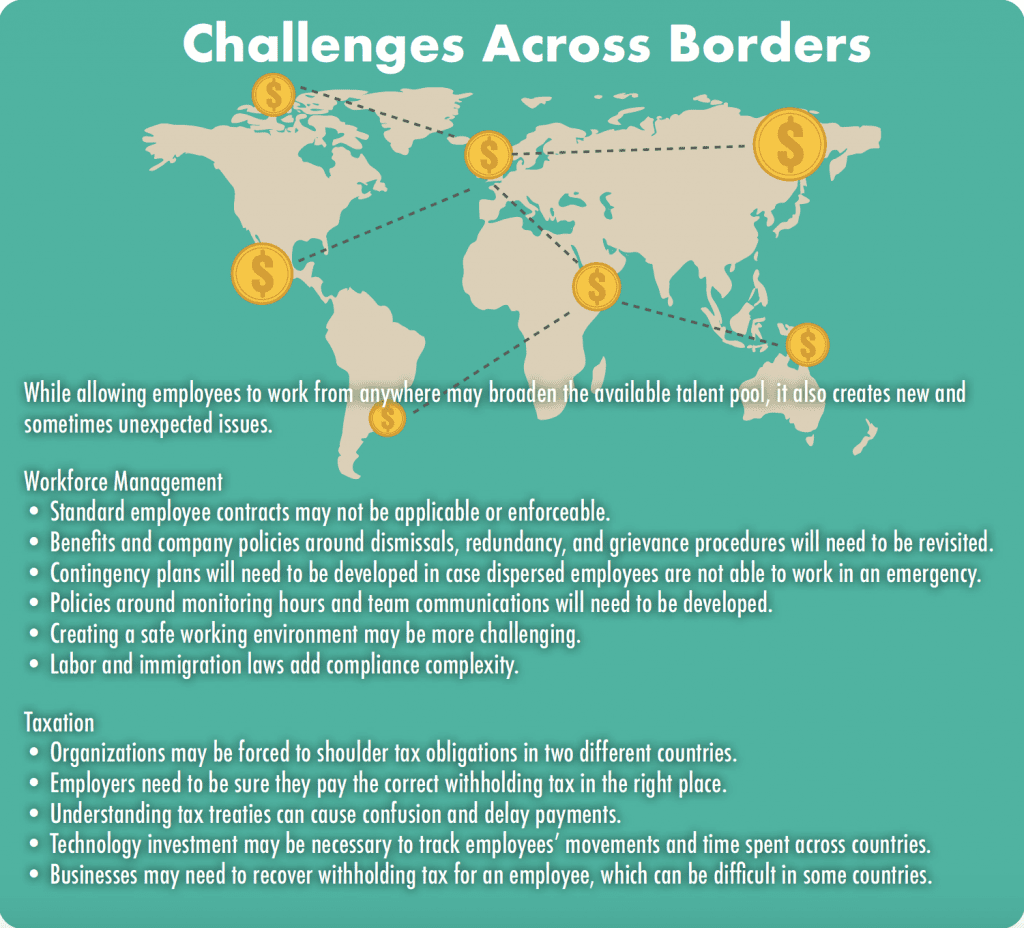Strategies to maintain payroll and tax compliance now that employees are working anywhere, anytime.
By Matthew Blaker and Michael Van Den Brand
At the moment, the only thing certain about business is that nothing is certain. The impact of the COVID-19 pandemic has made it more challenging for businesses to understand what “normal” looks like. Uncertainty combined with the elevated need to protect the health and safety of the workforce has meant that flexible and remote working is a viable solution for many. However, it is not without its complications when it comes to HR, payroll, and business operations.
As remote working becomes embedded as a medium- and long-term reality for many businesses, there are three key questions leaders should ask.
- Does the organization have a firm grasp on the legal, HR, tax, social security, payroll, benefits, and risk and compliance issues resulting from workplace changes due to COVID-19?
- What sorts of processes need to be put in place to manage future challenges?
- Are existing business plans agile enough to embrace opportunities, rebound from the pandemic, and thrive in the future?
Confronting Change
The global workplace has been undergoing change for many years. While labor centralization -employees working together in one location -has been the traditional model for centuries, advances in technology have increasingly enabled remote work. Meanwhile, travel and globalization have fueled employee mobility and allowed businesses to tap into international labor pools, changing operating models in the process. Indeed, the availability of flexible working and mobility have become, in some instances, a key tool for attracting and retaining talent.
But in early 2020, COVID-19 spread around the world and created a new dynamic in the working world. Not only did the pandemic accelerate some areas of existing transformation, such as digital transformation, but it acted as a catalyst for others. The most significant has been the seismic shift from working in offices to working from home. While this proved difficult for many businesses and individuals in the beginning, organizations adapted at an unprecedented speed.
COVID-19 has also created another shift. Travel restrictions and lockdowns during the pandemic have shown that costs associated with travel can be reduced while the need for physical offices has been called into question. Indeed, the media has been flooded with news of multinational companies that have already announced they expect a significant proportion of their workforce to work remotely in the near future.
Taking this trend further, progressive employers could move to a pure talent model: the best talent for the best price, wherever it is available.
While many of these potential changes feel largely positive, revolutionizing entrenched working practices and opening up the world of work will come with distinct challenges. There are likely to be significant implications for businesses that attempt to embrace the decentralized “new normal” of employees working anywhere, anytime. As such, businesses need to be aware of the potential pitfalls of making operational changes and plan for them accordingly.
The Broader Employment Picture
Working from anywhere may broaden the available pool of talent as geographical constraints are removed, but it throws up new and sometimes unexpected issues.
First, the employee contract needs to account for the legal place of employment and the nature of employment. Standard contracts may not be applicable as terms and conditions may not be enforceable where the employee resides, works, and travels.
Secondly, pension, healthcare, and employee benefits will need to be considered, as will dismissal, redundancy, and grievance procedures. Organizations must have effective continuity and contingency plans if employees are unable to work in an emergency situation, as was evidenced in the early days of the pandemic. Considering employees may be working remotely or travelling extensively, businesses should have protocols in place to locate their people at very short notice.
Organizations also need to outline clear expectations and policies around how working hours are monitored. Challenges inherent for teams unable to meet face-to-face must also be considered.
In many countries, employers have a legal obligation to provide a safe working environment for their employees. This is easier to control on their own premises, but it becomes more complex when employees are working remotely.
It is also critical for companies with a global workforce to comply with labor laws and immigration requirements and to continue to monitor these laws and adapt quickly to change.
For businesses opening up their global workforce and allowing remote working while making accommodations for personal preferences, a bespoke approach that is built specifically around their needs could be a viable option. Employers need to create solutions to address various working arrangements so that their workforce delivers maximum value and they do not inadvertently exclude or discourage one talent pool in favor of another.
Taxation Challenges
Taxation across borders is complex and the rules differ -often significantly -from one jurisdiction to the next. In many countries, the taxation of employment income is the biggest share of revenues generated by governments.
As the workforce becomes more mobile and globally spread, so too do the challenges to ensure that tax liabilities are met. Organizations must pay the correct withholding tax in the right place. Employers are typically subject to taxes based on where their employees perform their work, while employees are often subject to taxes based on where they reside. This could create tax obligations in two or more places as well as payroll withholding obligations in the country where the employee resides. Similarly, pension, healthcare, and employee benefits often follow different treatments in different jurisdictions.
Tax treaties are designed to arbitrate where the rules conflict -but not all tax treaties are the same and they are often interpreted differently by tax authorities in different countries. The interpretation and application of the tax regulations requires expert knowledge and can cause timing issues with recovering payments.
For business travelers or employees who spend time in multiple countries, it is important to identify how many days an employee spends in each location. This may need to be reported through one or more international payroll in each cycle.
Businesses may need to recover withholding tax for an employee if it was not due because of their tax situation, and this can be very difficult in some countries. Consideration must also be given to social security contributions to ensure that payments are made, there is appropriate cover, and employees are aware of their coverage in the right location. Most of these taxation issues are the employer’s responsibility and will create an additional burden for the payroll function.
Other tax implications exist, such as additional tax declarations and payments that may be required from the employee. Businesses may have an obligation to assist with tax bills or provide loans to deal with double taxation of an employee while they apply for a tax refund.
Additionally, if employees are performing revenue-generating or value-creating activities, this may subject company profits to corporate taxation in a different country. Businesses also need to be cautious around employees creating issues around permanent establishments.
Managing Workforce Issues
The global workforce landscape is constantly shifting, accelerated by COVID-19. As a result, businesses need people with the right skills in place to manage the legal, HR, tax, social security, payroll, compensation and benefits, and risk and compliance challenges outlined above. Legislation also changes on a regular basis, so it is essential that organizations are agile, continuously scan the horizon, and are able to adapt and make changes as necessary.
The skills needed to manage all of these challenges should be assessed across the whole organization, not just at headquarters. Organizations may find that they need to outsource or co-source certain activities if they aren’t present within the business. Employers must also invest in technology to track their workforce across boundaries and document policies and processes so they are understood and followed by all employees.
Budgets should be updated to reflect the additional costs of payroll transactions when employees move across countries, either constantly or sequentially, triggering tax filing requirements in multiple jurisdictions. A cost-benefit analysis will show the anticipated savings against the additional cost burden.
The Future is Bright, Even if Uncertain
The advancement of technology, changes to employee expectations, and increasing pressure on employers have created an opportunity for people to work with far more flexibility and agility than ever before.
Achieving this is not as easy as one might first think, however; employers must carefully consider the impact of any workplace transformation and conclude whether it is right for them.
It is key that businesses are aware of the compliance and talent implications of any changes and be prepared to continuously monitor and adapt as circumstances evolve both internally and externally.
The new demand for advanced mobility will be far more employee-driven, compared to the traditional company-driven approach -and companies need to be ready to meet employee demands to attract and retain top talent. Embracing this opportunity will allow many employers to consider radically different models for their workforce, giving them access to a much broader talent pool, diverse workforce, and potentially lower labor costs.
Matthew Blaker is partner in the people advisory services practice at EY. Michael Van Den Brand is global payroll markets and EMEIA payroll operate leader at EY.
Editor’s Note: The views reflected in this article are the views of the author and do not necessarily reflect the views of the global EY organization or its member firms.















